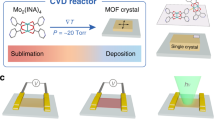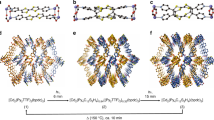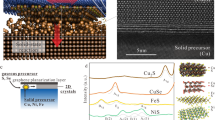Abstract
Considerable effort is being devoted to the fabrication of nanoscale devices1. Molecular machines, motors and switches have been made, generally operating in solution2,3,4,5,6,7, but for most device applications (such as electronics and opto-electronics), a maximal degree of order and regularity is required8. Crystalline materials would be excellent systems for these purposes, as crystals comprise a vast number of self-assembled molecules, with a perfectly ordered three-dimensional structure9. In non-porous crystals, however, the molecules are densely packed and any change in them (due, for example, to a reaction) is likely to destroy the crystal and its properties. Here we report the controlled and fully reversible crystalline-state reaction of gaseous SO2 with non-porous crystalline materials consisting of organoplatinum molecules. This process, including repetitive expansion–reduction sequences (on gas uptake and release) of the crystal lattice, modifies the structures of these molecules without affecting their crystallinity. The process is based on the incorporation of SO2 into the colourless crystals and its subsequent liberation from the orange adducts by reversible bond formation and cleavage10. We therefore expect that these crystalline materials will find applications for gas storage devices and as opto-electronic switches11,12.
This is a preview of subscription content, access via your institution
Access options
Subscribe to this journal
Receive 51 print issues and online access
$199.00 per year
only $3.90 per issue
Buy this article
- Purchase on Springer Link
- Instant access to full article PDF
Prices may be subject to local taxes which are calculated during checkout





Similar content being viewed by others
References
Fox, M. A. Fundamentals in the design of molecular electronic devices: long-range charge carrier transport and electronic coupling. Acc. Chem. Res. 32, 201–207 (1999).
Kelly, T. R., De Silva, H. & Silva, R. A. Unidirectional rotary motion in a molecular system. Nature 401, 150–152 (1999).
Koumura, N., Zijlstra, R. W. J., van Delden, R. A., Harada, N. & Feringa, B. L. Light-driven monodirectional molecular rotor. Nature 401, 152– 155 (1999).
Balzani, V., Gómez-López, M. & Stoddart, J. F. Molecular machines. Acc. Chem. Res. 31, 405–414 (1998).
Sauvage, J. P. Transition metal-containing rotaxanes and catenanes in motion: toward molecular machines and motors. Acc. Chem. Res. 31, 611–619 (1998).
Fabbrizzi, L., Licchelli, M. & Pallavicini, P. Transition metals as switches. Acc. Chem. Res. 32, 846–853 ( 1999).
Collier, C. P. et al. Electronically configurable molecular-based logic gates. Science 285, 391–394 ( 1999).
Liu, C. -Y. & Bard, A. J. Optoelectronic properties and memories based on organic single-crystal thin films. Acc. Chem. Res. 32, 235–245 (1999).
Dunitz, J. D. in Perspectives in Supramolecular Chemistry. The Crystal as a Supramolecular Entity (ed. Desiraju, G. R.) 7 (Wiley, Chichester, 1996).
Albrecht, M., Gossage, R. A., Lutz, M., Spek, A. L. & van Koten, G. Diagnostic organometallic and metallodendritic materials for SO2 gas detection: reversible binding of sulfur dioxide to aryl platinum(II) complexes. Chem. Eur. J. 6, 1431–1445 (2000).
Chen, P., Wu, X., Liu, J. & Tan, K. L. High H2 uptake by alkali-doped carbon nanotubes under ambient pressure and moderate temperatures. Science 285, 91– 93 (1999).
Dillon, A. C. et al. Storage of hydrogen in single-walled carbon nanotubes. Nature 386, 377–379 ( 1997).
Ohashi, Y., Yanagi, K., Kurihara, T., Sasada, Y. & Ohgo, Y. Crystalline-state reaction of cobaloxime complexes by X-ray exposure. An order-to-order racemization in the crystal of [(S)-1-cyanoethyl](pyridine)-bis(dimethylglyoximato)cobalt(III). J. Am. Chem. Soc. 104, 6353– 6359 (1982).
Novak, K., Enkelmann, V., Wegner, G. & Wagener, K. B. Crystallographic study of a single crystal to single crystal photodimerization and its thermal reverse reaction. Angew. Chem. Int. Edn Engl. 32, 1614–1616 (1993).
Kobatake, S., Yamada, T., Uchida, K., Kato, N. & Irie, M. Photochromism of 1,2-bis(2,5-dimethyl-3-thienyl)perfluorocyclopentene in a single crystalline phase. J. Am. Chem. Soc. 121, 2380–2386 (1999).
Scheffer, J. R. & Pokkuluri, P. R. in Photochemistry in Organized & Constrained Media (ed. Ramamurthy, V.) 185 (VCH, New York, 1990).
Langeley, P. J. & Hulliger, J. Nanoporous and mesoporous organic structures: new openings for materials research. Chem. Soc. Rev. 28, 279–291 (1999).
Estermann, M., McCusker, L. B., Baerlocher, C., Merouche, A. & Kessler, H. A synthetic gallo phosphate molecular sieve with a 20-tetrahedral-atom pore opening. Nature 352, 320–323 (1991).
Hajdu, J. et al. Millisecond X-ray diffraction and the first electron density map from Laue photographs of a protein crystal. Nature 329, 178–181 (1987).
Buss, C. E. et al. Structural investigations of vapochromic behavior. X-ray single-crystal and powder diffraction studies of [Pt(CN-iso-C3H7) 4][M(CN)4] for M = Pt or Pd. J. Am. Chem. Soc. 120, 7783–7790 ( 1998).
Desiraju, G. R. Crystal Engineering; The Design of Organic Solids (Elsevier, Amsterdam, 1989).
Lehn, J.-M. Supramolecular Chemistry: Concepts and Perspectives (VCH, Weinheim, 1995).
van Koten, G. Tuning the reactivity of metals held in a rigid ligand environment. Pure Appl. Chem. 61, 1681–1694 (1989).
Davies, P. J. et al. Organoplatinum building blocks for one-dimensional hydrogen-bonded polymeric structures. Angew. Chem. Int. Edn Engl. 35 , 1959–1961 (1996).
Braga, D., Grepioni, F. & Desiraju, G. R. Crystal engineering and organometallic architecture. Chem. Rev. 98, 1375–1405 (1998).
Albrecht, M. & van Koten, G. Gas sensor materials based on metallodendrimers. Adv. Mater. 11, 171– 174 (1999).
Darensbourg, M. Y., Tuntulani, T. & Reibenspies, J. H. Structure/function relationships in ligand-based SO2/O2 conversion to sulfate as promoted by nickel and palladium thiolates. Inorg. Chem. 34, 6287 –6290 (1995).
Moffat, K. Time-resolved crystallography. Acta Crystallogr. A 54, 833–841 (1998).
Kong, J. et al. Nanotube molecular wires as chemical sensors. Science 287, 622–625 ( 2000).
Acknowledgements
We thank E. T. H. Lutz and A. M. M. Schreurs for technical assistance during the measurements and R. A. Gossage for discussions. This work was partially supported by the Council for Chemical Sciences from the Dutch Organization for Scientific Research (CW–NWO).
Author information
Authors and Affiliations
Corresponding author
Rights and permissions
About this article
Cite this article
Albrecht, M., Lutz, M., Spek, A. et al. Organoplatinum crystals for gas-triggered switches. Nature 406, 970–974 (2000). https://doi.org/10.1038/35023107
Received:
Accepted:
Issue Date:
DOI: https://doi.org/10.1038/35023107
This article is cited by
-
Supramolecular inorganic chemistry leading to functional materials
Journal of Chemical Sciences (2020)
-
Fast and stable vapochromic response induced through nanocrystal formation of a luminescent platinum(II) complex on periodic mesoporous organosilica
Scientific Reports (2019)
-
Successive modification of polydentate complexes gives access to planar carbon- and nitrogen-based ligands
Nature Communications (2019)
-
Theoretical studies on the thermodynamics and kinetics of one-pot synthesis of aromatic PCP and PNP pincer ligands
Structural Chemistry (2018)
-
Selective guest inclusion by crystals of calixarenes: potential for application as separation materials
Journal of Inclusion Phenomena and Macrocyclic Chemistry (2018)
Comments
By submitting a comment you agree to abide by our Terms and Community Guidelines. If you find something abusive or that does not comply with our terms or guidelines please flag it as inappropriate.



